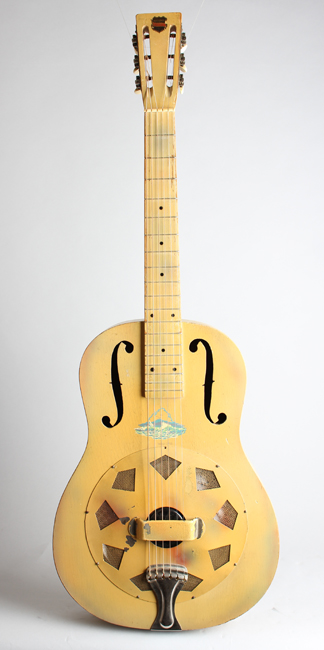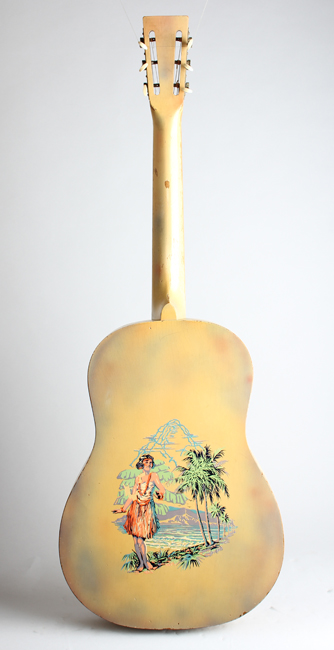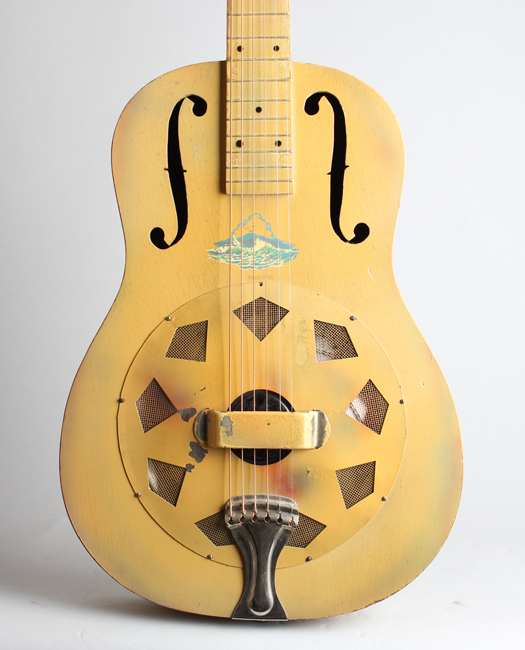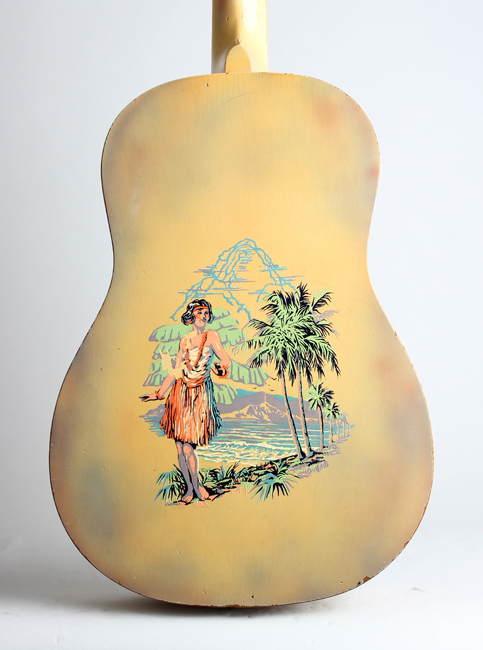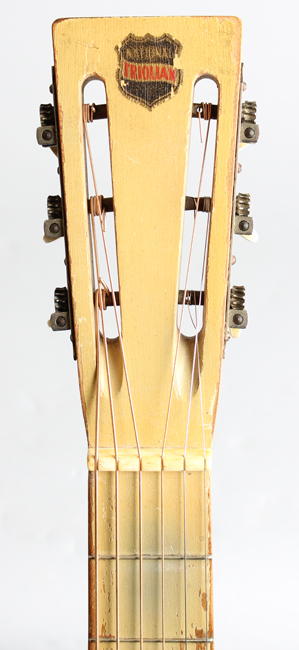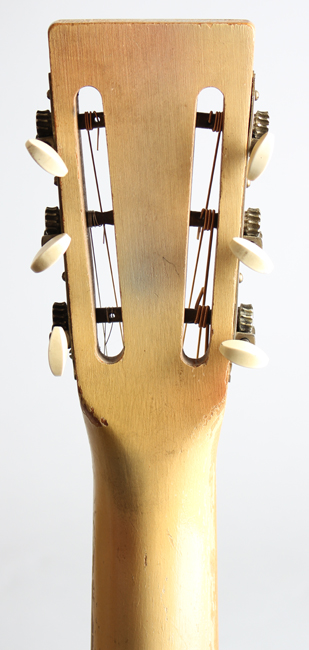National Triolian Resophonic Guitar (1929)
This item has been sold.
Item # 7461
Prices subject to change without notice.
National Triolian Model Resophonic Guitar (1929), made in Los Angeles, serial # 729, Polychrome lacquer with decals finish, laminated wood body, basswood neck, original black chipboard case.
This rare guitar is from the first series of single-cone National reso-phonic guitars to have been made, designed just before the Great Depression made lower-priced instruments a necessity. This wooden-body version of Triolian was only available for only a fairly brief period, introduced in late 1928 and discontinued in the last quarter 1929. National had tried a triple-cone version of this wood-body instrument (hence the name "Triolian") but quickly found the concept of a budget Tricone uneconomical. The single cone design proved easier and cheaper to make, but as National was more equipped to work with metal than wood the stamped steel body was adapted as a more efficient production expediency. This version was quickly replaced by the much more common metal body Triolian, built in the thousands through the 1930's.
There are many differences between this early Triolian and the later common models. This guitar's twelve fret basswood neck has an unbound, painted fingerboard with black dot inlay. The laminated wooden body is painted yellow with very subtle airbrushed red and blue highlights. The words "PATAPP FOR" are stamped directly on top between fingerboard just above resonator cover. There is a beautiful full-color stencil of Hula girl on back and an ocean wave on front, both unique to this model. The tuners are the same fairly fancy engraved-plate Waverly strips used on the Tricones of the period.
The single cone guitars that descended from this first model ensured the National company's survival during the depression, being far less expensive to produce than the elaborate Tricone that had previously been their sole product . This style Triolian is historically significant, representative of both the earliest commercial single-cone guitar and the first wooden body resonator instrument. It is also a wonderful sounding guitar, with a deep and surprisingly sweet tone quite unlike its steel-bodied brothers in both feel and tone.
Overall length is 39 in. (99.1 cm.), 14 in. (35.6 cm.) wide at lower bout, and 3 3/8 in. (8.6 cm.) in depth at side, taken at the end block. Scale length is 25 in. (635 mm.). Width of nut is 1 15/16 in. (49 mm.). This instrument is in quite well preserved condition, with only some typical flaking to the often quite fragile original Polychrome paint finish. This is most notable on the fingerboard edge, back body edges and coverplate in the handrest area. There is one old back/side seam separation on the side just below the tailpiece solidly sealed and a worn-away spot to the back edge below the tailpiece. The unique Hula Girl and Hawaiian wave stencils unique to this model have commonly flaked away at least partially; in this case the Hula girl on the back of the guitar shows some loss to the arm and neck area, and wave just under the fingerboard is practically perfectly complete. The "National Triolian" headstock decal shows some loss to the edges but is still substantially intact. The action is currently 4/32" at the 12th fret; it works well for Delta-style blues playing with fingers and a slide or as a standard playing guitar. Few of these early wood-body Triolians remain in this sort of condition; this one even includes the rare original chipboard also quite well preserved. Overall Excellent Condition.
This rare guitar is from the first series of single-cone National reso-phonic guitars to have been made, designed just before the Great Depression made lower-priced instruments a necessity. This wooden-body version of Triolian was only available for only a fairly brief period, introduced in late 1928 and discontinued in the last quarter 1929. National had tried a triple-cone version of this wood-body instrument (hence the name "Triolian") but quickly found the concept of a budget Tricone uneconomical. The single cone design proved easier and cheaper to make, but as National was more equipped to work with metal than wood the stamped steel body was adapted as a more efficient production expediency. This version was quickly replaced by the much more common metal body Triolian, built in the thousands through the 1930's.
There are many differences between this early Triolian and the later common models. This guitar's twelve fret basswood neck has an unbound, painted fingerboard with black dot inlay. The laminated wooden body is painted yellow with very subtle airbrushed red and blue highlights. The words "PATAPP FOR" are stamped directly on top between fingerboard just above resonator cover. There is a beautiful full-color stencil of Hula girl on back and an ocean wave on front, both unique to this model. The tuners are the same fairly fancy engraved-plate Waverly strips used on the Tricones of the period.
The single cone guitars that descended from this first model ensured the National company's survival during the depression, being far less expensive to produce than the elaborate Tricone that had previously been their sole product . This style Triolian is historically significant, representative of both the earliest commercial single-cone guitar and the first wooden body resonator instrument. It is also a wonderful sounding guitar, with a deep and surprisingly sweet tone quite unlike its steel-bodied brothers in both feel and tone.
Overall length is 39 in. (99.1 cm.), 14 in. (35.6 cm.) wide at lower bout, and 3 3/8 in. (8.6 cm.) in depth at side, taken at the end block. Scale length is 25 in. (635 mm.). Width of nut is 1 15/16 in. (49 mm.). This instrument is in quite well preserved condition, with only some typical flaking to the often quite fragile original Polychrome paint finish. This is most notable on the fingerboard edge, back body edges and coverplate in the handrest area. There is one old back/side seam separation on the side just below the tailpiece solidly sealed and a worn-away spot to the back edge below the tailpiece. The unique Hula Girl and Hawaiian wave stencils unique to this model have commonly flaked away at least partially; in this case the Hula girl on the back of the guitar shows some loss to the arm and neck area, and wave just under the fingerboard is practically perfectly complete. The "National Triolian" headstock decal shows some loss to the edges but is still substantially intact. The action is currently 4/32" at the 12th fret; it works well for Delta-style blues playing with fingers and a slide or as a standard playing guitar. Few of these early wood-body Triolians remain in this sort of condition; this one even includes the rare original chipboard also quite well preserved. Overall Excellent Condition.
